Some day I’m going to actually get around to this, checking on the earlier history of my Seattle neighborhood to see if cherry trees figured prominently back when. Our house is nearly surrounded by them. To one side an ancient, sprawling Rainier tree packed with cherries that I can spy from my seat here at the computer. In our own front yard a crazy-tall tree of sour cherries, far too tall to make access to the cherries at all reasonable. I just picked 3 ripe ones this morning, not enough to even make one tartlet! And best of all, across our backyard fence is another large tree that puts out the most distinctive cherries I’ve ever seen or tasted.
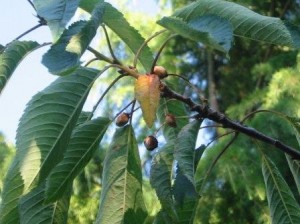 The couple branches that extend over to our patio only grant me access to a tiny selection of the fruit. And the birds, far more nimble and acrobatic than I, get to most of them before I do. Check out this crazy picture, they carefully eat the fruit from the pit while it’s still hanging on the tree, leaving remains that make it look like a cherry-pit tree! I was able to nab one single cherry this weekend that the birds had somehow missed, in perfect ripe form. The color of both the skin and the flesh is of a royal purple so deep as to be nearly black. It just explodes with juiciness and powerful cherry flavor. But I can see this never being a good commercial fruit, definitely tender and surely quite delicate once plucked from the tree. I split it in half to share with my sister. My single annual dose of a mystery heritage cherry until about this time next year.
The couple branches that extend over to our patio only grant me access to a tiny selection of the fruit. And the birds, far more nimble and acrobatic than I, get to most of them before I do. Check out this crazy picture, they carefully eat the fruit from the pit while it’s still hanging on the tree, leaving remains that make it look like a cherry-pit tree! I was able to nab one single cherry this weekend that the birds had somehow missed, in perfect ripe form. The color of both the skin and the flesh is of a royal purple so deep as to be nearly black. It just explodes with juiciness and powerful cherry flavor. But I can see this never being a good commercial fruit, definitely tender and surely quite delicate once plucked from the tree. I split it in half to share with my sister. My single annual dose of a mystery heritage cherry until about this time next year.
Thankfully, there are other cherries to be had this time of year. Though it has been a particularly hard season for Washington cherry growers. Due in large part to the exceptionally cold spring, harvest is running at about half its normal levels throughout the Northwest. Which also means prices are a bit higher, but I’m willing to pay a little more to still get my summertime fill and to support the local farmers.
While eating great cherries as they are–heck, it’s good enough for all those birds!–is wonderful, there are a few recipes I love to pull out come cherry season. A particular favorite is clafoutis, a rustic French dessert that really couldn’t be easier. I included a clafoutis recipe in my Northwest Homegrown cookbook Stone Fruit, there using fresh plums instead. Cherries are traditional, however, the recipe I use based on that from a very dear friend, Anne-Marie, from France. I’ll surely revisit Anne-Marie in posts to come, she helped orchestrate the study abroad program I did in Dijon a couple decades back. Then, and in years since when I’ve spent time visiting with her and her family, Anne-Marie has provided some of the most memorable dining experiences of my life. That’s “dining” in a totally unaffected, straightforward, start-with-the-best-ingredients-and-don’t-mess-them-up fashion. It proved a wonderful counterpoint to my more formal training at La Varenne.
So, back to the clafoutis. Rub softened butter over the bottom and sides of a gratin dish or similar shallow baking dish. Pit enough cherries to loosely cover the bottom (classically, pits are left in the cherries but I prefer pre-pitted); plums, apricots and ripe pears are other fruits I’d recommend, pitted/cored and cut into appropriate pieces. I think peaches would likely be too sweet for this recipe.
In a medium bowl, combine 1/2 cup sugar with 1/2 cup all-purpose flour and a pinch of salt. Whisk to mix. In another bowl, whisk together 3 eggs, then add 1 1/4 cups milk and 1 teaspoon pure vanilla extract and whisk to blend. Add the egg mixture to the dry mixture and gently stir with the whisk just until smooth. The result will look something like a thin pancake batter. Pour the batter into the gratin dish. Put the dish in a 425 degree F oven, immediately turning the temp down to 375 degrees. Bake until set and lightly browned around the edges, 30 to 40 minutes. In the book, I recommend dotting with butter at 30 minutes, sprinkling with 1 tablespoon of sugar and returning to the oven to create a sugary crust. But honestly, I prefer it unadorned.
The clafoutis will puff up as it bakes, then settle again as it cools. Don’t worry, that’s the intention! Not a dessert to eat hot, I prefer it at room temperature. This made for a perfect dessert last night on the patio, after a dinner of salade niçoise with grilled salmon and grilled tuna. Oh, and a bottle of Chinook winery’s cabernet franc rosé wine. No more ideal summertime supper than that! Well, maybe tonight’s grilled burgers will be a contender. I’m fickle that way.

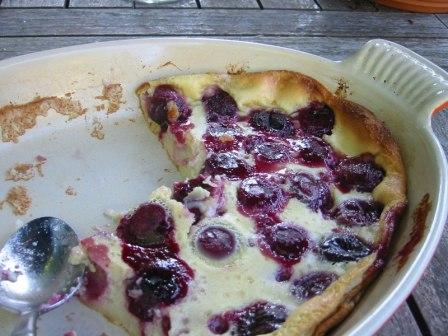

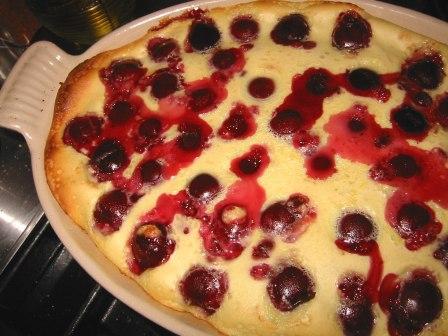
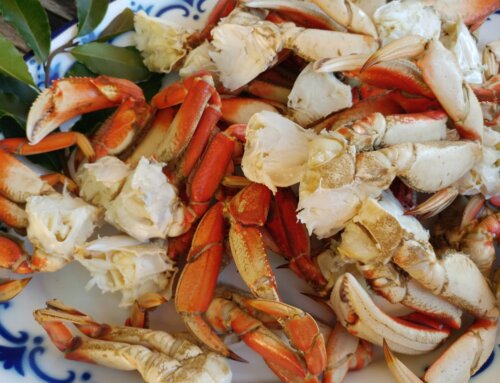
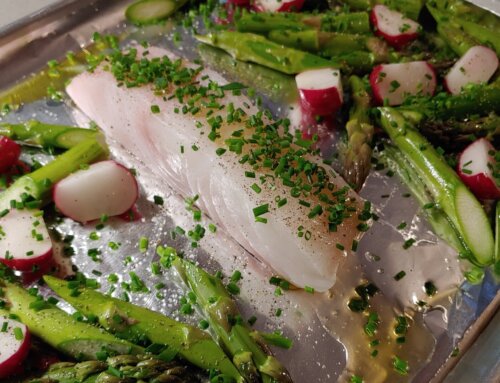
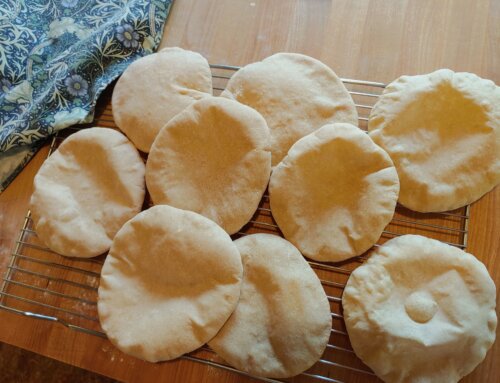
Cynthia, just want to thank you for this idea. Sue found it in your Stone Fruit book and made it using cherries from our 50 year old Royal Anne cherry tree. Just delicious. I forwarded the link to Gwen Phibbs who says she is making it, too. Great idea.
[…] I followed this recipe, a regular in my summertime roster that always takes me back a few decades to a friend’s […]